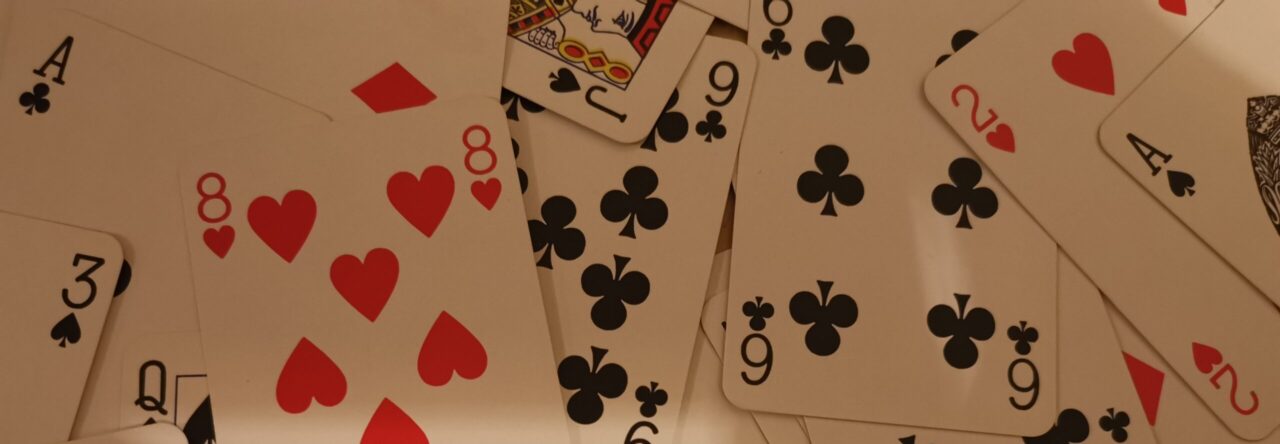The Lavings convention is a simple way of asking for 5 card majors after partner has opened a strong or weak NT.
After an opening 1NT Bid and 2♣ Response
So it’s important to known you can only bid 2♣ with invitational hands.
| Bid | Meaning |
| 2♦ | Minimum no 5 card Major |
| 2♥ | Minimum 5 card hearts |
| 2♠ | Minimum 5 card spades |
| 2NT | Maximum no 5 card suit |
| 3♣ | Maximum 5 card club suit |
| 3♦ | Maximum 5 card diamond suit |
| 3♥ | Maximum 5 card heart suit |
| 3♠ | Maximum 5 card spade suit |
Continuations after 2♦
So after 1NT – 2♣ – 2♦ uninterrupted
| Bid | Meaning |
| 2♥ | 5 card suit non-forcing |
| 2♠ | 5 card suit non-forcing |
| 2NT | To Play |
| 3♣ | Promissory 4 card Stayman |
| 3♦ | 3 Card Stayman |
| 3♥ | Shows 5 spades and 4 Hearts |
| 3♠ | Shows 5 hearts and 4 Spades |
Continuations after 2NT
So after 1NT – 2♣ – 2NT uninterrupted. 3♣ would be promissory Stayman and a bid of 3♦ would ask for a 3 card major.
Some Examples
Let’s look at some examples of strong and Weak NT openers.
| a) | b) | c) | d) |
| ♠ AQ1083 ♥ K8 ♦ KJ7 ♣ A97 | ♠ AJ53 ♥ J54 ♦ QJ72 ♣ K7 | ♠ KJ4 ♥ K108 ♦ AQ762 ♣ A7 | ♠ KJ862 ♥ 42 ♦ KQ7 ♣ AJ10 |
| ♠ 954 ♥ A74 ♦ Q8543 ♣ K3 | ♠ Q73 ♥ KQ973 ♦ A65 ♣ 43 | ♠ Q72 ♥ AQ962 ♦ 93 ♣ 953 | ♠ Q73 ♥ KQ973 ♦ A65 ♣ 43 |
| e) | f) | g) | h) |
| ♠ AQ862 ♥ 42 ♦ KQ7 ♣ KJ10 | ♠ KJ82 ♥ 42 ♦ KQ7 ♣ AJ107 | ♠ KJ8 ♥ 42 ♦ KQJ7 ♣ A1092 | ♠ KJ62 ♥ 42 ♦ KQ7 ♣ AJ107 |
| ♠ J73 ♥ K10973 ♦ 43 ♣ A65 | ♠ Q763 ♥ KQ93 ♦ A65 ♣ 43 | ♠ Q763 ♥ KQJ3 ♦ 1073 ♣ K5 | ♠ Q1073 ♥ KQ73 ♦ A65 ♣ 43 |
| i) | |||
| ♠ K82 ♥ AQJ6 ♦ A982 ♣ K8 | |||
| ♠ AJ943 ♥ 1094 ♦ QJ3 ♣ A7 |
The Bidding
a) 1NT (15-17) – 2♣ – 3♠ – 4♠
So the 3♠ shows a maximum and you simply raise it to 4♠
b) 1NT (12-14) – 2♣ – 2♦ – 2♥
Partner has invitational 5 card heart suit but after just bidding 2♥ you can pass this even with 3 card support.
c) 1NT (15 – 17) – 2♣ – 3♦ – 3♥ – 4♥
The original NT bidder is maximum with a 5 card diamond suit. You now bid your 5 card heart suit (game forcing) which gets supported to 4♥.
d) 1NT (12 – 14) – 2♣ – 3♠ – 4♠
The original NT bidder is maximum with a 5 card spade suit. You now bid 4♠.
e) 1NT (15-17) – 2♣ – 2♠
So the 2♠ shows a minimum with 5 spades which you can just pass.
f) 1NT (12-14) – 2♣ – 2NT – 3♣ – 3♠ – 4♠
2NT shows a maximum without any 5 card suit. 3♣ is promissory Stayman (it guarantees a 4 card major) and partner bids 3♠ which then gets raised to 4♠.
g) 1NT (12 – 14) – 2♣ – 2NT – 3♣ – 3♦ – 3NT
The 2NT shows a maximum without any 5 card suit. 3♣ is promissory Stayman (it guarantees a 4 card major) and partner bids 3♦ which denies a 4 card major. 3NT is then bid.
h) 1NT (12 – 14) – 2♣ – 2NT – 3♣ – 3♥ – 3NT – 4♠
The 2NT shows a maximum without any 5 card suit. 3♣ is promissory Stayman (it guarantees a 4 card major) and partner bids 3♥. 3NT is bid as you don’t like hearts and partner converts to the known 4-4 spade fit and bids 4♠.
g) 1NT (15 – 17) – 2♣ – 2NT – 3♦ – 3♥ – 3NT – 4♠
The 2NT shows a maximum without any 5 card suit. 3♦ asks for a 3 card major (should guarantee a 5 card major) and partner bids 3♥. 3NT is bid which partner can either pass or bid 4♠ if they have 3 card spade support.
So that’s how to play the Lavings bidding convention….a five card major ask after an opening 1NT.
